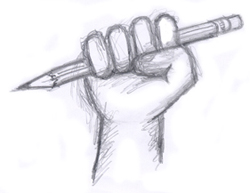It seems that once again, a small but growing movement is occurring within the graphic design industry in which traditional illustration skills are being looked upon as being of unique importance. This is certainly not to say that computer skills are not of equal importance, as today’s advertising media require a successful designer to not only have them, but to maintain a high level of proficiency. Rather, the aforementioned movement (maybe too strong a word) looks upon the two as complementary, if not even symbiotic skills, and of equal value. Good news for those of us who stand with one foot on each side of this discipline divide.
Designer or and Illustrator

Successful designers and Creative Directors have long been telling aspiring young designers to turn off their computers and get a firm handle on the basics first. Learn to draw, learn to think, learn to simply express a concept on paper and share it with others through dialog (see Don Moyer’s Napkin Sketches 101). Sage advise, without a doubt. But illustration, whether it be as a means to an end, or as a step in the process through which a concept is portrayed to clients or colleagues, holds far more value than a step in a designer’s training. Obviously, illustrators must routinely make design decisions, and graphic designers must illustrate at times. But in today’s industry, not only are the two disciplines regularly crossing paths, but many of today’s designers are striving to combine illustration into their design work in new (or old) ways, myself among them.
What goes around…
With the trend toward computer art nearly two decades old, the design industry is beginning to witness a resurgence of hand-done, non-computerized looking projects. Some designers are intentionally including “mistakes” in their computer-enhanced work to “take the polished edges off” or provide a more organic look –something well beyond the often over-used grunge look or various software filters/effects. It is difficult to tell what is fueling this emerging trend. Perhaps it is a response to the inevitable backlash as many designers grow frustrated with the compuscentric world in which we find ourselves spending far to much time. Or perhaps it is being driven by the ad industry, as some agencies seek new ways to tap into content-hungry audiences with messages that cut through the cliches and too-slick imagery.
The bottom line
Perhaps we are at last approaching the end of the debate between “illustrator” vs “designer”, getting beyond the preconception-laden labels. Graphic design is about problem solving and story telling —developing solutions to the challenges to delivering clear, concise messages to media-savvy consumers in cluttered, drive-through economy. The last thing any creative professional should be thinking about is these industry labels and their constraints, real or perceived. Rather, we should be using the tools available to us to create unique, effective solutions. We should be seeking opportunities to unleash our passions —passion for design, passion for dealing with our clients’ needs, or passion for learning more about the world through our work. This leaves little room for the baggage of labels.

